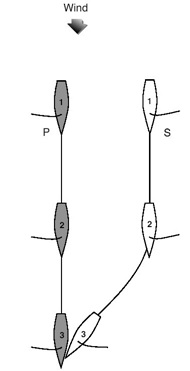



CASE 105
Rule 10, On Opposite Tacks
Rule 14, Avoiding Contact
Rule 15, Acquiring Right of Way
Rule 16.1, Changing Course
When two boats are running on opposite tacks, the
starboard-tack boat may change course provided she gives
the port-tack boat room to keep clear.
Facts
After sailing alongside P for some time on port tack, S gybes to starboard
tack without breaking rule 15. Both boats continue to sail parallel courses.
About two minutes after her gybe S begins to luff. P does not respond to the
luff and the boats touch at position 3. There is no damage or injury.

Questions
At the time of the contact, does rule 15 still apply? Does S break rule 16?
Answers
S as the starboard-tack boat has right of way under rule 10, and P as the
port-tack boat must keep clear. Rule 15 applies only briefly after S becomes
the right-of-way boat, but rule 16.1 continues to limit how S may change
course. S may luff provided that she does so in a way that gives P room to
keep clear, and P must be prepared to react promptly, if necessary by gybing,
to continue to keep clear. Since P has room to keep clear of S by responding
promptly when S luffs, S does not break rule 16.1. P does not keep clear and
does not avoid contact with S. P is therefore penalized for breaking rules 10
and 14.
S also breaks rule 14 because, after it became clear that P was not keeping
clear, S could have avoided the contact. However, because there was no
damage or injury she was exonerated by rule 43.1(c).
DEN 2005






